Abstract
Omnivores can dampen trophic cascades by feeding at multiple trophic levels, yet few studies have evaluated how intraspecific variation of omnivores influences community structure. The speckled dace (Rhinichthys osculus) is a common and omnivorous minnow that consumes algae and invertebrates. We studied effects of size and size structure on top-down control by dace and how effects scaled with density. Dace were manipulated in a mesocosm experiment and changes in invertebrate and algal communities and ecosystem function were monitored. Omnivores affected experimental communities via two distinct trophic pathways (benthic and pelagic). In the benthic pathway, dace reduced macroinvertebrate biomass, thereby causing density-mediated indirect effects that led to increased benthic algal biomass. Dace also reduced pelagic predatory macroinvertebrate biomass (hemipterans), thereby increasing the abundance of emerging insects. The effect of dace and hemipterans on emerging insects was mediated by a non-linear response to dace with peak emergence at intermediate dace density. In contrast with recent studies, omnivore size and size structure had no clear effect, indicating that small and large dace in our experiment shared similar functional roles. Our results support that the degree to which omnivores dampen trophic cascades depends on their relative effect on multiple trophic levels, such that the more omnivorous a predator is, the more likely cascades will be dampened. Availability of abundant macroinvertebrates, and the absence of top predators, may have shifted dace diets from primary to secondary consumption, strengthening density-dependent trophic cascades. Both omnivore density and dietary shifts are important factors influencing omnivore-mediated communities.





Similar content being viewed by others
References
Anderson TL, Semlitsch RD (2016) Top predators and habitat complexity alter an intraguild predationmodule in pond communities. J Anim Ecol 85:548–558
Arar EJ, Collins GB (1997) Method 4450: In vitro determination of chlorophyll a and pheophytin a in marine and freshwater algae by fluorescence. United States Environmental Protection Agency, Office of Research and Development, National Exposure Research Laboratory, Cincinnati
Bates D, Maechler M, Bolker B, Walker S (2015) Fitting linear mixed-effects models using lme4. J Stat Soft 67:1–48
Baxter CV, Fausch KD, Murakami M, Chapman PL (2004) Fish invasion restructures stream and forest food webs by interrupting reciprocal prey subsidies. Ecology 85:2656–2663
Baxter CV, Fausch KD, Carl Saunders W (2005) Tangled webs: reciprocal flows of invertebrate prey link streams and riparian zones. Fresh Biol 50:201–220
Benke AC, Huryn AD, Smock LA, Wallace JB (1999) Length-mass relationships for freshwater macroinvertebrates in North America with particular reference to the southeastern United States. JNABS 18:308–343
Blaustein L, Kotler BP, Ward D (1995) Direct and indirect effects of a predatory backswimmer (Notonecta maculata) on community structure of desert temporary pools. Ecol Entomol 20:311–318
Bolker BM, Brooks ME, Clark CJ, Geange SW, Poulsen JR, Stevens MHH, White JSS (2009) Generalized linear mixed models: a practical guide for ecology and evolution. Trends Ecol Evol 24:127–135
Breviglieri CPB, Oliveira PS, Romero GQ (2017) Fear mediates trophic cascades: nonconsumptive effects of predators drive aquatic ecosystem function. Am Nat 189:490–500
Brose U, Hillebrand H (2016) Biodiversity and ecosystem functioning in dynamic landscapes. Philos Trans R Soc B 371:20150267
Brose U, Blanchard JL, Eklöf A, Galiana N, Hartvig M, M. Hirt MR, Kalinkat G, Nordström MC, O’gorman EJ, Rall BC, Schneider FD, (2017) Predicting the consequences of species loss using size-structured biodiversity approaches. Biol Rev 92:684–697
Bruno JF, O’Connor MI (2005) Cascading effects of predator diversity and omnivory in a marine food web. Ecol Lett 8:1048–1056
Buck TL, Breed GA, Pennings SC, Chase ME, Zimmer M, Carefoot TH (2003) Diet choice in an omnivorous salt-marsh crab: different food types, body size, and habitat complexity. J Exp Mar Biol Ecol 292:103–116
Cabana G, Rasmussen JB (1996) Comparison of aquatic food chains using nitrogen isotopes. Proc Natl Acad Sci 93:10844–10847
Cachera M, Ernande B, Villanueva MC, Lefebvre S (2017) Individual diet variation in a marine fish assemblage: optimal foraging theory, niche variation hypothesis and functional identity. J Sea Res 120:60–71
Carpenter SR, Kitchell JF, Hodgson JR (1985) Cascading trophic interactions and lake productivity. Bioscience 35:634–639
Carter PE, Rypstra AL (1995) Top-down effects in soybean agroecosystems: spider density affects herbivore damage. Oikos 72:433–439
Clark W, Elmblad W (2010) Field report: Kimball Creek Fishery Survey, Garfield County, Colorado. Grand Junction. Unpublished report available from High Lonesome Ranch, De Beque, CO
Cobbaert D, Bayley SE, Greter JL (2010) Effects of a top invertebrate predator (Dytiscus alaskanus; Coleoptera: Dytiscidae) on fishless pond ecosystems. Hydrobiologia 644:103–114
Coll M, Guershon M (2002) Omnivory in terrestrial arthropods: mixing plant and prey diets. Annu Rev Entomol 47:267–297
DeVries DR, Stein RA (1991) Comparison of three zooplankton samplers: a taxon-specific assessment. J Plankton Res 13:53–59
Downing AL, Leibold MA (2002) Ecosystem consequences of species richness and composition in pond food webs. Nature 416:837–841
Edeline E, Lacroix G, Delire C, Poulet N, Legendre S (2013) Ecological emergence of thermal clines in body size. Glob Change Biol 19:3062–3068
Estes JA, Duggins DO (1995) Sea otters and kelp forests in Alaska: generality and variation in a community ecological paradigm. Ecol Monogr 65:75–100
Estes JA, Terborgh J, Brashares JS, Power ME, Berger J, Bond WJ, Carpenter SR, Essington TE, Holt RD, Jackson JB, Marquis RJ (2011) Trophic downgrading of planet earth. Science 333:301–306
Finke DL, Denno RF (2005) Predator diversity and the functioning of ecosystems: the role of intraguild predation in dampening trophic cascades. Ecol Lett 8:1299–1306
Finke DL, Denno RF (2006) Spatial refuge from intraguild predation: implications for prey suppression and trophic cascades. Oecologia 149:265–275
Genner MJ, Sims DW, Southward AJ, Budd GC, Masterson P, McHugh M, Rendle P, Southall EJ, Wearmouth VJ, Hawkins SJ (2010) Body size-dependent responses of a marine fish assemblage to climate change and fishing over a century-long scale. Glob Change Biol 16:517–527
Gianuca AT, Pantel JH, De Meester L (2016) Disentangling the effect of body size and phylogenetic distances on zooplankton top-down control of algae. Philos Trans R Soc B 283:20160487
Hauer FR, Lamberti GA (2007) Methods in stream ecology, 2nd edn. Academic Press, San Diego
Hunter MD, Price PW (1992) Playing chutes and ladders: heterogeneity and the relative roles of bottom-up and top-down forces in natural communities. Ecology 73:723–732
Ibrahim AN, Noll MS, Valenti WC (2015) Zooplankton capturing by Nile Tilapia, Oreochromis niloticus (Teleostei: Cichlidae) throughout post-larval development. Zoologia (Curitiba) 32:469–475
Johnson JH (1985) Comparing diets of paiute sculpin, speckled dace, and subyearling steelhead trout in tributaries of the Clearwater River, Idaho. Northwest Sci 59:1–9
Katano O (2007) Effects of experimental duration and density of Japanese dace Tribolodon hakonensis on the strength of trophic cascades on benthic algae. Oecologia 154:195–205
Kratina P, Hammill E, Anholt BR (2010) Stronger inducible defences enhance persistence of intraguild prey. J Anim Ecol 79:993–999
Kratina P, LeCraw RM, Ingram T, Anholt BR (2012) Stability and persistence of food webs with omnivory: is there a general pattern? Ecosphere 3:1–18
Křivan V, Diehl S (2005) Adaptive omnivory and species coexistence in tri-trophic food webs. Theor Popul Biol 67:85–99
Kuznetsova A, Brockhoff PB, Christensen RHB (2016) lmerTest: tests in linear fixed effects models. R package version 2.0-33. https://www.CRAN.R-project.org/package=lmerTest. Accessed 20 Apr 2017
Lenth RV (2016) Least-squares means: the R package lsmeans. J Stat Softw 69:1–33. https://doi.org/10.18637/jss.v069.i01
Li HW, Moyle PB (1976) Feeding ecology of the pit sculpin, Cottus pitensis in Ash Creek, California. Bull South Calif Acad Sci 75:111–118
Lindo Z (2015) Warming favours small-bodied organisms through enhanced reproduction and compositional shifts in belowground systems. Soil Biol Biochem 91:271–278
Long ZT, Bruno JF, Duffy JE (2011) Food chain length and omnivory determine the stability of a marine subtidal food web. J Anim Ecol 80:586–594
Malison RL, Benjamin JR, Baxter CV (2010) Measuring adult insect emergence from streams: the influence of trap placement and a comparison with benthic sampling. JNABS 29:647–656
Marcarelli AM, Baxter CV, Mineau MM, Hall RO (2011) Quantity and quality: unifying food web and ecosystem perspectives on the role of resource subsidies in freshwaters. Ecology 92:1215–1225
Moyle PB, Vondracek B (1985) Persistence and structure of the fish assemblage in a small California stream. Ecology 66:1–13
Okun N, Brasil J, Attayde JL, Costa IA (2008) Omnivory does not prevent trophic cascades in pelagic food webs. Freshw Biol 53:129–138
Östman Ö, Eklöf J, Eriksson BK, Olsson J, Moksnes PO, Bergström U (2016) Top-down control as important as nutrient enrichment for eutrophication effects in North Atlantic coastal ecosystems. J Appl Ecol 53:1138–1147
Pace ML, Cole JJ, Carpenter SR, Kitchell JF (1999) Trophic cascades revealed in diverse ecosystems. Trends Ecol Evol 14:483–488
Paine RT (1969) The Pisaster-Tegula interaction: prey patches, predator food preference, and intertidal community structure. Ecology 50:950–961
Peckarsky BL, McIntosh AR (1998) Fitness and community consequences of avoiding multiple predators. Oecologia 113:565–576
Pfrender ME, Hicks J, Lynch M (2004) Biogeographic patterns and current distribution of molecular-genetic variation among populations of speckled dace, Rhinichthys osculus (Girard). MolPhylogenet Evol 30:490–502
Pilger TJ, Gido KB, Propst DL (2010) Diet and trophic niche overlap of native and nonnative fishes in the Gila River, USA: implications for native fish conservation. Ecol Freshw Fish 19:300–321
Pimm SL, Lawton JH (1978) On feeding on more than one trophic level. Nature 275:542–544
Pinder LCV (1986) Biology of freshwater Chironomidae. Annu Rev Entomol 31:1–23
Polis GA, Myers CA, Holt RD (1989) The ecology and evolution of intraguild predation: potential competitors that eat each other. Annu Rev Ecol and Syst 20:297–330
Post DM (2002) Using stable isotopes to estimate trophic position: models, methods, and assumptions. Ecology 83:703–718
Power ME (1990) Effects of fish in river food webs. Science 250:811–814
Power ME (1992) Top-down and bottom-up forces in food webs: do plants have primacy? Ecology 73:733–746
Preisser EL, Bolnick DI, Benard MF (2005) Scared to death? The effects of intimidation and consumption in predator–prey interactions. Ecology 86:501–509
Propst DL, Gido KB (2004) Responses of native and nonnative fishes to natural flow regime mimicry in the San Juan River. Trans Am Fish Soc 133:922–931
Pujoni DGF, Maia-Barbosa PM, Barbosa RAR, Fragoso CR Jr, van Nes EH (2016) Effects of food web complexity on top-down control in tropical lakes. Ecol Model 320:358–365
Pyke GH, Pulliam HR, Charnov EL (1977) Optimal foraging: a selective review of theory and tests. Q Rev Biol 52:137–154
Quist MC, Hubert WA, Isaak DJ (2004) Fish assemblage structure and relations with environmental conditions in a Rocky Mountain watershed. Can J Zool 82:1554–1565
R Development Core Team (2016) R: a language and environment for statistical computing. R Foundation for Statistical Computing, Vienna, Austria. URL https://www.R-project.org/. Accessed 20 Apr 2017
Renneville C, Rouzic AL, Baylac M, Millot A, Loisel S, Edeline E (2015) Morphological drivers of trophic cascades. Oikos 125:1193–1202
Richardson DC, Charifson DM, Stanson VJ, Stern EM, Thompson JE, Townley LA (2016) Reconstructing a trophic cascade following unintentional introduction of golden shiner to Lake Minnewaska, New York, USA. Inland Waters 6:29–33
Ripple WJ, Estes JA, Schmitz OJ, Constant V, Kaylor MJ, Lenz A, Motley JL, Self KE, Taylor DS, Wolf C (2016) What is a trophic cascade? Trends Ecol Evol 31:842–849
Ritchie EG, Johnson CN (2009) Predator interactions, mesopredator release and biodiversity conservation. Ecol Lett 12:982–998
Rudolf VH (2008) Consequences of size structure in the prey for predator–prey dynamics: the composite functional response. J Anim Ecol 77:520–528
Rudolf VH, Rasmussen NL (2013) Ontogenetic functional diversity: size structure of a keystone predator drives functioning of a complex ecosystem. Ecology 94:1046–1056
Schmitz OJ, Hambäck PA, Beckerman AP (2000) Trophic cascades in terrestrial systems: a review of the effects of carnivore removals on plants. Am Nat 155:141–153
Seegert SEZ, Rosi-Marshall EJ, Baxter CV, Kennedy TA, Hall RO Jr, Cross WF (2014) High diet overlap between native small-bodied fishes and nonnative fathead minnow in the Colorado River, Grand Canyon, Arizona. Trans Am Fish Soc 143:1072–1083
Sheridan JA, Bickford D (2011) Shrinking body size as an ecological response to climate change. Nat Clim Change 1:401–406
Sih A, Englund G, Wooster D (1998) Emergent impacts of multiple predators on prey. Trends Ecol Evol 13:350–355
Sinclair ARE (2003) Mammal population regulation, keystone processes and ecosystem dynamics. Philos Trans R Soc Lond B Biol Sci 358:1729–1740
Soulé ME, Bolger DT, Alberts AC, Wrights J, Sorice M, Hill S (1988) Reconstructed dynamics of rapid extinctions of chaparral-requiring birds in urban habitat islands. Conserv Biol 2:75–92
Start D, Gilbert B (2017) Predator personality structures prey communities and trophic cascades. Ecol Lett 20:366–374
Stevenson CF, Demes KW, Salomon AK (2016) Accounting for size-specific predation improves our ability to predict the strength of a trophic cascade. Ecol Evol 6:1041–1053
Terborgh J, Estes JA (2010) Trophic cascades: predators, prey, and the changing dynamics of nature. Island Press, Washington, DC
Terborgh J, Lopez L, Nunez P, Rao M, Shahabuddin G, Orihuela G, Riveros M, Ascanio R, Adler GH, Lambert TD, Balbas L (2001) Ecological meltdown in predator-free forest fragments. Science 294:1923–1926
Thompson RM, Hemberg M, Starzomski BM, Shurin JB (2007) Trophic levels and trophic tangles: the prevalence of omnivory in real food webs. Ecology 88:612–617
Van de Wolfshaar KE, De Roos AM, Persson L (2006) Size-dependent interactions inhibit coexistence in intraguild predation systems with life-history omnivory. Am Nat 168:62–75
Werner EE, Gilliam JF (1984) The ontogenetic niche and species interactions in size-structured populations. Annu Rev Ecol Syst 15:393–425
Williams RJ, Martinez ND (2004) Limits to trophic levels and omnivory in complex food webs: theory and data. Am Nat 163:458–468
Winnie J Jr, Creel S (2017) The many effects of carnivores on their prey and their implications for trophic cascades, and ecosystem structure and function. Food Webs 12:88–94
Wootton KL (2017) Omnivory and stability in freshwater habitats: does theory match reality? FreshwBiol 62:821–832
Acknowledgements
We thank A. Glass and A. Allen for help in the field and/or laboratory as well as R. Rothenbuecher, K. Boeckman and S. Peterson for helpful comments and information. Many thanks to M. Flinn, C. Mecklin, and T. Spier for guidance and feedback and to M. Torres, R. Baker, and A. Lackey for manuscript comments. Special thanks to P. Vahldiek, S. Mahoney, S. Stewart, M. Nelson, and A. Schultz from the High Lonesome Ranch (HLR) and High Lonesome Institute (HLI) for logistical and emotional support. We are very appreciative for field assistance provided by Colorado Parks and Wildlife, especially J. Logan. Lastly, thanks to G. Harris and A. Hayden at Hancock Biological Station (HBS) for logistical and laboratory support. Generous financial support was provided by the HLR, HLI, and Watershed Studies Institute (WSI).
Author information
Authors and Affiliations
Contributions
DJB and HHW conceived and designed the experiments. DJB performed the experiments and analyzed the data. DJB and HHW wrote the manuscript.
Corresponding author
Ethics declarations
Conflict of interest
The authors declare they have no conflict of interest.
Data accessibility
We intend to archive all relevant data in the Dryad Digital Repository.
Ethical approval
All applicable institutional and/or national guidelines for the care and use of animals were followed.
Additional information
Communicated by David Chalcraft.
Supplementary Information
Below is the link to the electronic supplementary material.
Rights and permissions
About this article
Cite this article
Benkendorf, D.J., Whiteman, H.H... Omnivore density affects community structure through multiple trophic cascades. Oecologia 195, 397–407 (2021). https://doi.org/10.1007/s00442-020-04836-0
Received:
Accepted:
Published:
Issue Date:
DOI: https://doi.org/10.1007/s00442-020-04836-0




